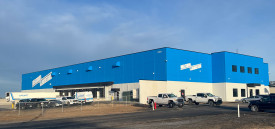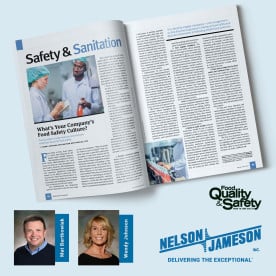Monthly Archives: August 2012
- August 29, 2012
This past July, an unsettling story came out that detailed how several passengers on four Delta flights, bound for the United States from the Netherlands, bit into sandwiches containing small needles. The FBI, Delta Airlines, and Gate Gourmet, the Amsterdam-based company that produced the meals, all took the event quite seriously, as surely as many travelers did as well when hearing of the story.
These types of events prompt the food industry to reflect further on a major focus of the Food Safety Modernization Act (FSMA): food security and food defense. Food safety issues resulting from mistakes and/or negligence have largely been the focus of many media outlets, but the need to protect the food chain from malicious attacks is another key area of concern in the market and within the FSMA itself. No matter the motive, Gate Gourmet is treating the case
- August 27, 2012
For the next three months, “The Wide Line” blog will feature a series of columns authored by Dan Strongin, a well-known name in the food industry.
Do you think it’s crazy to argue against cutting costs and advocate for not paying what appears to be the lowest price? I don’t blame you for thinking so; it’s natural because “cutting costs make more profit” is so logical, but, logical or not, except in the very short term, it is not true. What matters is lowering overall costs. The true cost is what the company has to spend for each dollar of sales, not what it spends on each individual part. If you care about profit as much as I think you do, you will invest in the time to digest this.
To help, I am including a link to the video page at the Deming Collaboration. At the bottom of the list on that page are links to three YouTube videos that go into depth using real world examples of how cost cutting can put you out of business. I do ask your forbearance as they are among the first I did, and while jam packed with goodies, are not Disney-level productions.
Click here to watch videos.
Watching costs alone is not enough in today’s rough and tumble business environment, and truthfully, it probably never was. If you have been buying on price alone, purchasing inventory you won’t use for months to get an even lower price, or buying from 15 different sources, a bit from here and a bit from there, don’t feel bad! You are not alone. Sadly!
I never saw a company that was forced to sell, that wasn’t drowning in excess packaging and supplies. Many companies fail to meet their long-term potential because they believe that old lie, “watch your costs, the rest will take care of itself.” Cost is just one part of the equation. We will cover the whole equation more in the next post.
- August 21, 2012
For the next three months, “The Wide Line” blog will feature a series of columns authored by Dan Strongin, a well-known name in the food industry.
In 1947, when Nelson Jameson was founded, there were 3000 cheese plants in the state of Wisconsin. As I write this, in 2012, there are 140. The same thing has happened in the rest the country, and not just in dairy, but in most industries, with the exception of computer electronics.
We're all in the same boat even if it sometimes feels like it’s sinking. Survival in consolidating markets is usually bought at the price of lower margins. As “commodity” markets mature, the choice is almost always made to compete on price. Dollars profit per pound becomes pennies, and companies are forced to find ways to survive on ever-smaller, already razor-thin margins at greater volumes of production.
Food plants in 1947 operated in a far simpler environment than that of today. The computer and the Internet have sped things up so much, spitting data at us faster than we can swallow it; I don't need to tell you! Just look at how logistics has changed. The food economy now depends on exports, not just imports. Who would have thought, fifteen years ago, that would be the case in today’s market?
And the icing on the cake is the burden of requirements to keep up with, including: safety audits, environmental standards –the challenge of keeping up with all the forms, all the information, and the rapid pace of change, and the ever increasing complexity of choosing the best possible product. Remember, you also still need time to make that product, and to figure out how to make a profit from it!
All of you know this, but what you may not know is according to the Bureau of Labor standards, only a fraction of businesses are profitable even after a decade in business. It’s tough, and there is little room for error.
There is a silver lining in all of this, if it were easy you have a lot more competitors. No one can afford any longer to manage by shooting from the hip, or going with his or her gut. In the old days, you could get away with simplistic notions like buy low sell high. Today, buying on price alone will put you out of business. Have I lost my mind? How can cost-cutting put you out of business? We need real knowledge to survive, to understand business in new, more effective ways.
- August 14, 2012
For the next three months, “The Wide Line” blog will feature a series of columns authored by Dan Strongin, a well-known name in the food industry.
You are a professional buyer, and I can't possibly know anything more about your particular job or your particular business than you do. I also know that most likely you didn't come to this site to only read this blog.
We are both professionals. I want to make these posts truly useful to you! You won't find fancy marketing language here listing the benefits of buying from Nelson-Jameson, though there are many. You get enough of that sort of language in the market today and I am at that glorious stage in life where I only agree to do things if I believe in them. And I believe in Nelson-Jameson. I have reason to, but more on that later.
For the next few weeks, I'm going to pull no punches. If what I write upsets you, don't let it! I will challenge, needle, and push you. No matter how much anyone knows, you can't grow without pulling out some dead wood, and you can’t evolve without killing some sacred cows. And that never feels good until after the fact.
I may not know about your particular job as a buyer, but for more than a couple of decades I was a buyer, a good one, and in a few different industries. I know more than most about the supply chain, because I have spent years studying it, and what I know about price, true cost, and inventory can make your company a lot of money.
So strap on your seat belts, put on your crash helmets, and get ready, because, like it or not, we're going to be talking about statistics. Statistics!?! Feeling sleepy? Don't worry...I am not talking about abstract statistics and squiggly symbols, but practical statistics, and statistical thinking, because everything about effective buying has to do with prediction, probabilities, and lowering exposure to risk.
This week though, I would like to focus on a terrible syndrome I suffered from when I was a beginning buyer called the myopia syndrome.
At that time, the only thing I looked at were the individual items suppliers sold. If I needed an item, and they were the only ones who had it, I bought it no matter what the price. If they were one of a handful of people who had it, I would buy from the one with the lowest price. It was not until many years on the job that I took on a more holistic approach.
Now before you say, “what a hack!” Remember, that was a different era. At that point, we didn't suffer from information overload. The computer, improvements in logistics, free trade, and world markets, along with pretty complicated regulations, certifications, and audit requirements changed all this. As all of you know better than I, there always seems to be more information, more products, more requirements, and less time.
And the old-fashioned buyer who only cared about paying the lowest price, would be lost in today's increasingly complex world. Because the price you pay for an item is not the only cost. The time you need to learn about all the possible choices out there isn't there, and the ever-increasing cost of everything else means that smart operators have to learn to partner with their suppliers to cut through the noise. They need to focus as many resources as they can on what they do best, which for a buyer should be effectively managing their inventory dollars. As we will see in the coming weeks, the faster the flow of raw materials to products sold, the greater the profit.
When I finally overcame my myopia syndrome, I realized that suppliers sold so much more than just individual items. To thrive, I needed to understand their whole package including the following: the sum total of all the items, all the categories, all the services and how they related to each other, and most importantly, their people.
I could no longer depend on chance to find out everything they had to offer, and somehow had to make the time to really study how they might help me and my company overall. This moment of clarity came about when I started to do competitive cuttings, comparing one product from one supplier with an equivalent product from another supplier, to know which would work best for me. Ironically, a larger business I was working with acquired another one of the suppliers I was using at that time. They both carried the exact same product at the exact same price, but when we started to test the product, to our surprise, though they were the same: same label, same package…the product from the smaller supplier was of much better quality. How can that be?
When I looked into it further, the root cause was that the former management still ran the smaller company, and being a family business, they treated their people with respect, and their employees liked working there. At the larger company where people hated working, goods would stay on the dock and in the sun longer, no one watched the thermostat, items were stashed in the wrong places, not rotated properly, beat up and abused, just like the people who worked there.
I realized, to evaluate a supplier properly would require much more than just checking out the prices. I started looking into every aspect of the company, everything they sold, everything they provided, who owned them, what their minimum requirement was, the quality of goods when delivered, quality of service, frequency of delivery, how responsive they were, and how much they knew about their product so they could help me use it more effectively. Finally, I kept a keen eye out for a company interested in more than just trying to get me for a buck. They needed to be watching my back.
- August 06, 2012
For the next three months, “The Wide Line” blog will feature a series of columns authored by Dan Strongin, a well-known name in the food industry. Strongin began his career in the food industry on the front lines as a chef. For two decades he worked as a five-star chef, including seven years with the Ritz Carlton Corporation. His passion for food and excellence was then put to work as the corporate chef and director of delicatessen operations for Andronico’s Markets, San Francisco. From 1995 to 1996 he served as the president of the American Cheese Society. He then became a managing partner and owner of Edible Solutions, a consulting company, and currently is a columnist for the Cheese Reporter. As a mentor for companies through Deming Collaboration, Strongin focuses on working with companies on effective management, strategic planning and marketing, and production systems.





